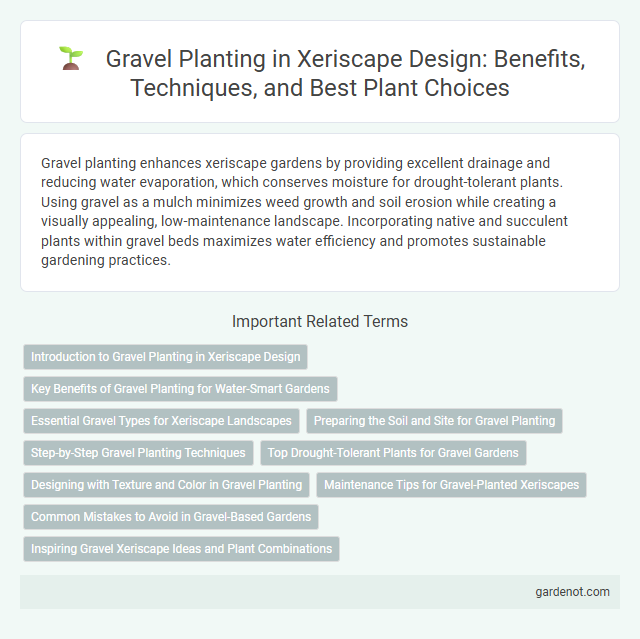Gravel planting enhances xeriscape gardens by providing excellent drainage and reducing water evaporation, which conserves moisture for drought-tolerant plants. Using gravel as a mulch minimizes weed growth and soil erosion while creating a visually appealing, low-maintenance landscape. Incorporating native and succulent plants within gravel beds maximizes water efficiency and promotes sustainable gardening practices.
Introduction to Gravel Planting in Xeriscape Design
Gravel planting in xeriscape design enhances water conservation by using drought-tolerant plants surrounded by gravel mulch, which reduces soil evaporation and suppresses weed growth. This technique optimizes soil moisture retention and minimizes irrigation needs, making it ideal for arid climates. Gravel acts as a thermal buffer, protecting plant roots from extreme temperatures and promoting healthy growth with minimal water usage.
Key Benefits of Gravel Planting for Water-Smart Gardens
Gravel planting enhances xeriscape gardens by significantly reducing water consumption, as gravel mulch minimizes soil evaporation and retains moisture effectively. This method improves soil temperature regulation and prevents weed growth, promoting healthier plant development with less irrigation. Gravel also supports sustainable landscaping by decreasing water runoff and erosion, making it an ideal choice for water-smart garden designs.
Essential Gravel Types for Xeriscape Landscapes
Gravel types essential for xeriscape landscapes include decomposed granite, pea gravel, and crushed rock, each offering unique benefits for water conservation and soil retention. Decomposed granite compacts well to provide a stable surface, while pea gravel allows excellent drainage, reducing water runoff. Crushed rock enhances erosion control and supports drought-tolerant plant roots by maintaining moisture levels.
Preparing the Soil and Site for Gravel Planting
Preparing the soil and site for gravel planting involves removing existing vegetation and debris to create a clean, stable base. Proper grading ensures adequate drainage, preventing water accumulation that could harm plants or gravel stability. Incorporating a layer of weed barrier fabric before laying gravel minimizes weed growth and maintains soil integrity.
Step-by-Step Gravel Planting Techniques
Gravel planting begins by selecting drought-tolerant plants suited for xeriscape environments, ensuring deep root systems that minimize water consumption. Prepare the soil by loosening it and mixing in organic compost before layering a weed barrier fabric to prevent unwanted growth. Spread an even layer of gravel mulch around the plants, maintaining appropriate spacing to allow air circulation and root expansion while retaining soil moisture efficiently.
Top Drought-Tolerant Plants for Gravel Gardens
Gravel gardens thrive with drought-tolerant plants like lavender, sedum, and Russian sage that require minimal water and thrive in well-draining, rocky soils. Succulents such as agave and yucca are ideal for xeriscape gravel planting due to their ability to store water and withstand prolonged dry conditions. Incorporating native grasses like blue fescue enhances gravel garden texture while ensuring sustainability and low maintenance in arid landscapes.
Designing with Texture and Color in Gravel Planting
Gravel planting combines diverse textures and colors to create visually striking xeriscape designs, enhancing both aesthetics and water efficiency. Incorporating contrasting gravel tones with succulents and drought-tolerant plants emphasizes depth and dimension while minimizing maintenance. Thoughtful placement of coarse and fine gravel textures alongside vibrant foliage fosters a dynamic landscape that complements arid environments.
Maintenance Tips for Gravel-Planted Xeriscapes
Gravel-planted xeriscapes require minimal watering, making them highly water-efficient and ideal for drought-prone regions. To maintain optimal appearance and functionality, routinely remove weeds by hand or with a non-toxic herbicide and replenish gravel annually to prevent soil erosion. Regularly check for debris buildup and ensure proper drainage to avoid water pooling, which can harm drought-tolerant plants like succulents and native grasses.
Common Mistakes to Avoid in Gravel-Based Gardens
Gravel gardening often suffers from improper soil preparation and inadequate drainage, leading to plant root rot and poor growth. Using plants that are not drought-tolerant or suitable for xeriscape conditions results in excessive water demand and maintenance challenges. Overcompacting gravel surfaces restricts air and water penetration, which negatively affects plant health and soil quality in gravel-based xeriscape gardens.
Inspiring Gravel Xeriscape Ideas and Plant Combinations
Gravel xeriscape combines drought-tolerant plants like lavender, sedum, and ornamental grasses to create visually appealing, low-maintenance landscapes. Incorporating succulents such as agave and echeveria with gravel mulch enhances soil moisture retention and prevents weed growth. Using contrasting gravel colors alongside textured foliage maximizes aesthetic appeal while conserving water efficiently.
Gravel planting Infographic

 gardenot.com
gardenot.com